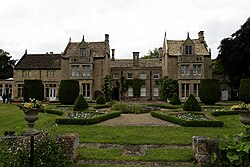Tolethorpe Hall
| Tolethrpe Hall | |
| Rutland | |
|---|---|
 Tolethorpe Hall | |
| Location | |
| Grid reference: | TF023104 |
| Location: | 52°40’54"N, 0°29’17"W |
| History | |
| Country house | |
| Information | |
| Owned by: | The Stamford Shakespeare Company |
Tolethope Hall is a country house in the parish of Little Casterton in Rutland, north of Stamford. Once a country seat for minor gentry, it is now the home of the Stamford Shakespeare Company and the grounds provide their famous open-air theatre, the Rutland Theatre.
From the A1 Great North Road, southbound, Tolethorpe Hall may be approached from the Old Great North Road (B1081) through the village of Little Casterton. It is about two miles from the A1. The grounds of Tolethorpe today occupy about seven acres.
History
For 800 years from around 1088 until 1839 it was the home of three distinguished families, the de Tolethorpes (1088–1316), the Burtons (1316–1503) and the Brownes (1503–1839).
Sir Thomas Burton (c.1369–1438), who owned Tolethorpe estates in his time, was the member of Parliament for Rutland three times and High Sheriff of Rutland three times.[1]
Francis Browne (died 1541) was member of Parliament for Stamford and High Sheriff for 1524. His grandson Robert Browne (c. 1550-1633), born at Tolethorpe, became the leader of the Brownists, early advocates of a congregational form of organisation for the Church of England. Having in 1580 attempted to set a separate church up in Norwich, he moved to Middelburg in the Netherlands in 1581.[2] He returned to England and to the Church of England, and was employed as a schoolmaster and parish priest.
The estate was acquired in the 1850s by the Eatons, a Stamford banking family. They sold it in 1967 to a Cambridgeshire farmer who in 1977 sold the near derelict hall and a few acres of land to the Stamford Shakespeare Company.
The Rutland Theatre

The hall and its gardens are now noted as an outdoor Shakespearian theatre. The Stamford Shakespeare Festival was founded in 1968, with a performance of A Midsummer Night’s Dream’’ in the courtyard of ‘’The George’’ in Stamford, and these continued until 1976, when the George was no longer available. The next year Tolethorpe Hall was put up for sale and with the aid of a generous loan the Stamford Shakespeare Company were able to buy it, and over the following years they worked hard to renovate what had become a dilapidated building, and to create the Rutland Theatre.
The grounds of the hall contain a natural amphitheatre. Tolethorpe Hall itself stands on the middle of three terraces cut in sloping ground. The slopes down to the valley have been transformed into the theatre The raked auditorium of the theatre is arranged on the lower slope, looking outward across the lower terrace which forms the open air stage behind which, is the open country of the Gwash Valley. Backdrop is rarely needed: actors can exit by vanishing among the trees which fringe the backstage.
The auditorium is permanently covered, and with fixed seats. The stage though is open to the elements, and in many performances the cast have become soaked.
The Stamford Shakespeare Company presents a three-month season each summer. Normally there are two Shakespeare plays and one by another playwright.
Outside links
| ("Wikimedia Commons" has material about Tolethorpe Hall) |
- Stamford Shakespeare Company
- Tolethorpe Hall – The American Connection (on members of the Browne family who settled in America)
References
- ↑ BURTON, Sir Thomas (c.1369-1438), of Tolethorpe Hall and Little Casterton, Rutland: History of Parliament Online
- ↑ Stamford Shakespeare Company - History
- Thorne, J.O. Chambers Biographical Dictionary (1969) ISBN 0-550-16001-9.
- Cantor, Leonard, The Historic Country Houses of Leicestershire & Rutland (1998) Kairos Press, ISBN 1-871344-15-8